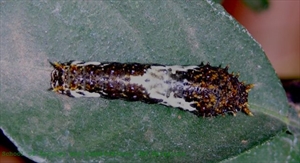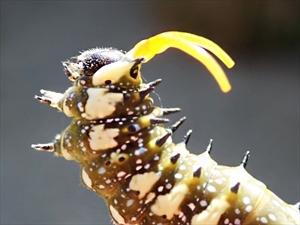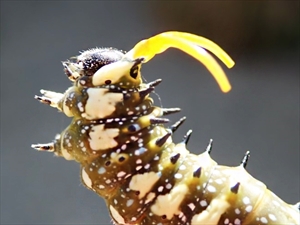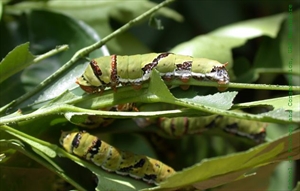Background
The Papilionidae or swallowtail butterflies are large colourful insects that are distributed globally. There are over 550 species and most of these are tropical. The name swallowtail refers to a tail-like extension of the hind wings of the adults, found in most papilionids. Many swallowtail caterpillars sequester toxic chemicals from their food plants rendering both them and the adults as distasteful and thus protection from predators. Most caterpillars are external feeders (Fig. 1, Fig. 2) but some tie leaves together with silk for shelters. Early instars often resemble bird droppings (Fig. 2).
Short Description
Adapted from Ackery et al. (1998)
Mature swallowtail caterpillars are stout, and are smooth, the so-called ‘smooth and green group’ (Fig. 1, Fig. 3), or have a series or sport fleshy tubercles on the dorsum, the ‘red, tuberculate group’. They sometimes have a raised fleshy protuberance (hood or crest) on A1. The most diagnostic feature for swallowtails is the osmeterium, situated on the dorsal side of T1 just behind the head. This is a fleshy, bifid, tentacle-like organ that is inflated and everted when the caterpillar feels threatened. It is usually brightly coloured and secretes a foul-smelling terpene based chemical to ward off potential predators. Parnassine caterpillars have conspicuous setae grouped onto pinacula or verrucae. On the other hand, Papilionine caterpillars are smooth and often have expanded thoracic segments imparting a humped appearance. They are also often brightly coloured with bands and bright colours, and eye spots, or contrastingly, may be cryptic. Fleshy filaments are also often present (Fig. 1).
Diagnosis
From Stehr et al. (1987), Ackery et al. (1998) and Braby (2000).
- Osmeterium (repugnatorial organ) situated in a pit on the dorsum of the prothorax that is, when disturbed, inflated with fluid from a transverse dorsal groove. Secretes a foul-smelling terpene-based fluid. Very diagnostic of this family as it is found found in all papilionid larvae. Note that this structure may not be everted in preserved specimens.
- T3 may be enlarged.
Detailed Description
From Stehr et al. (1987), Ackery et al. (1998) and Braby (2000).
Mature larvae are medium to large, with the body frequently widest at A1 and tapering to the head and also gradually to A10. The head is retractile and smaller than the prothorax (T1) (Fig. 1, Fig. 3). The integument often appears smooth, despite the frequent presence of numerous secondary setae. Species often have filaments (Fig. 1) and verrucae. Colour is very variable but is often in shades of brown, green and black (Fig. 1, Fig. 3). Primary setae may be absent or present, and inconspicuous, or supported by pinacula or verrucae. A diagnostic feature for the family that is unique in the Lepidoptera is the presence of an osmeterium on the dorsum of T1.
Head: The head is hypognathous (Fig. 1, Fig. 3) with the frontoclypeus as wide as or wider than long with straight margins and extending one-fourth to one-half to the epicranial notch. The ecdysial lines meet some distance above the frontoclypeal apex at usually at least a quarter of the length of the frontoclypeus beyond its apex. The labrum is notched. There are six stemmata; in Parnassius (Parnassinae), 1 and 5 are slightly separated from 2-4 and 6 is widely separated and posterior of the rest, while 5 is near the antennal base. In the Papilioninae, 1-4 and 6 form a group, often on a raised part of the head capsule, with 5 usually widely separated from the rest near the antennal base. On the head, secondary setae are numerous. The integument is smooth, slightly rough or reticulate.
Thorax: T1 is wider than the head (Fig. 1, Fig. 3). The prothoracic shield is usually present and divided mid-dorsally, but may be indistinct. It is often covered in secondary setae. An osmeterium is located on the dorsum of T1, usually just posterior to the head. In Parnassius (Parnassinae), verrucae mark the position of primary setae. On T1, dorsal verrucae are posterior to the prothoracic shield. SD, L and SV verrucae are arranged in a straight line, more or less. There are often long secondary setae with tuberculate bases on all thoracic segments. In the Papilioninae, there are usually no primary setae on the thorax, and in many species the thoracic segments become progressively larger posteriorly, giving a humped appearance (Fig. 3). The spiracle on T1 is elliptical or bean-shaped and is approximately the same size as or larger than that on A1.
Abdomen: The spiracles on A1-A8 are elliptical and usually the same size. Secondary setae are usually numerous all over the body, especially on the venter. Crochets are arranged in a biordinal or triordinal mesoseries on A3-A6, and a triordinal circle with a caudal gap on A10. Some species have a weakly developed biordinal lateroseries on A3-A6. In Parnassius (Parnassinae), SD, L, SV and V primary setae are indicated by verrucae. In many other species primary setae are absent or weakly present. The dorsum of A10 usually has numerous and long secondary setae.
Species of Biosecurity Concern
THE FOLLOWING SPECIES IS OF BIOSECURITY CONCERN TO NORTHERN AUSTRALIA
Papilio demoleus malayanus (lime swallowtail) (Papilionidae: Papilioninae)
Papilio demoleus malayanus is a sub-species of Papilio demoleus, and is of biosecurity concern to northern Australia. P. demoleus is a pest species that tends to attack citrus trees. It is believed to be the most widely distributed swallowtail butterfly in the world. There are six sub-species altogether in this species. P. d. malayanus occurs in Sumatra and the Malayan peninsula whereas P. d. sthenelus is found in Australia. The four remaining sub-species are widely distributed across Asia and P. d. demoleus has recently invaded the West Indies.
Description
The first instar caterpillar is black with a black head and has two rows of fleshy spines. Subsequent instars develop cryptic white markings so that they resemble bird droppings (Fig. 2). The mature caterpillar (instars 4, 5 and 6) is green on the dorsal side but greyish white on the venter, with a white, sub-spiracular, lateral band. It is cylindrical but tapered posteriorly. The head becomes orange and is covered with white secondary setae. Two, short, orange to green processes flank both sides of the anterior margin of the prothoracic shield. Similar processes flank each side of the dorsum of A9. The thoracic legs are also orange. The last, 5th instar caterpillar develops pale to orangish-brown, marbled, transverse bands on the intersegmental areas of the thorax, similar, with eye spots on the end of the band on T3. Darker, oblique bands continue over A4 and A5, and two similarly coloured blotches on the dorsum of A5 and a similar, short oblique band on A6 (Fig. 3). The osmeterium, when inflated, is yellow at the base becoming orange apically. The colours of the caterpillars are variable, and sometimes bands are missing.
For more images see: https://entnemdept.ifas.ufl.edu/Creatures/bfly/lime_swallowtail.htm
Biology and Feeding Damage
- When disturbed, caterpillars evert the osmeterium and rear its head back to startle would-be predators
- Five instars typically
- Caterpillars typically attack younger leaves and growing shoots. In major infestations defoliation occurs
- L1-L3 feed openly
- L4-6 rest on twigs at a distance form feeding area.
See CABI (2019)
Current Distribution
- Sumatra
- Malayan peninsula.
Caterpillar Host Plants
- Citrus species

Fig. 2. Early instar caterpillar of Papilio demoleus. Early instars resemble bird droppings. Photographed in India by School of Ecology and Conservation, UAS Bangalore, India - School of Ecology and Conservation, UAS Bangalore <kchandra58 @ yahoo.co.in>, CC BY 2.5, https://commons.wikimedia.org/w/index.php?curid=1104357.
References
Ackery, P. R., de Jong, R. & Vane-Wright, R. I. (1999). The Butterflies: Hedyloidea, Hesperioidea and Papilionoidea. In: Kristensen, N.P. (Ed.), Handbook of Zoology. 4(35.1). De Gruyter, Berlin, New York.
Braby, M. F. (2000). The Butterflies of Australia: Their Identification, Biology and Distribution. CSIRO Publishing, Victoria, Australia.
CABI (2019). Invasive Species Compendium. Papilio demoleus (chequered swallowtail). https://www.cabi.org/isc/datasheet/38758#4CF7E1CD-E738-412A-9DA7-8FF96CB8ED2E Accessed October 2019.
Lewis, D. S. (2008). Featured Creatures. Papilio demoleus. University of Florida. https://entnemdept.ifas.ufl.edu/Creatures/bfly/lime_swallowtail.htm Accessed October 2019.
Nazari, V. Sperling, F. A.H. (2006). Parnassiinae Duponchel, [1835]. Tree of Life. [Tree of Life Web Project]. Retrieved 3 October 2010. http://tolweb.org/Parnassiinae
Reed, Robert D.; Sperling, Felix A.H. (2006). "Papilionidae– The Swallowtail Butterflies". [Tree of Life Web Project]. Retrieved 3 October2019. http://tolweb.org/Papilionidae/12177
Stehr, F.W., Martinat, P.J., Davis, D.R., Wagner, D.L., Heppner, J.B., Brown, M.E., Toliver, M.E., Miller, J.Y., Downey, J.C., Harvey, D.J., McFarland, N., Neunzig, H.H., Godfrey, G.L., Habeck, D.H., Appleby, J.E., Jeffords, M., Donahue, J.P., Brown, J.W. & Frack, D.C. (1987) Order Lepidoptera, pp 288–596. In Stehr, F. W. (Ed.), Immature Insects. Kendall/Hunt, Dubuque.
 Papilio anactus
Papilio anactus
